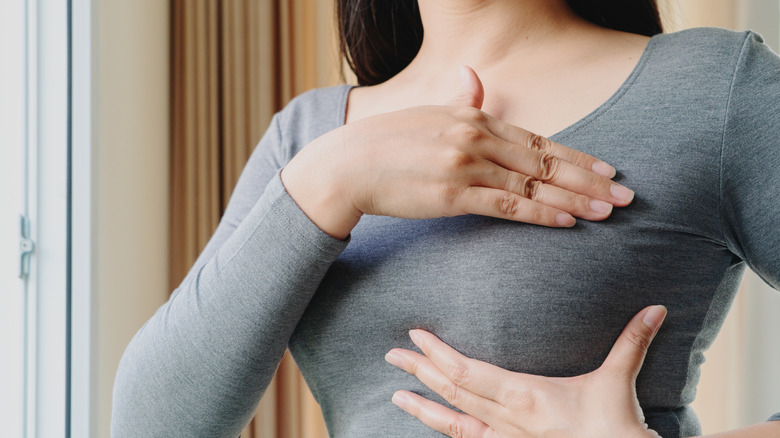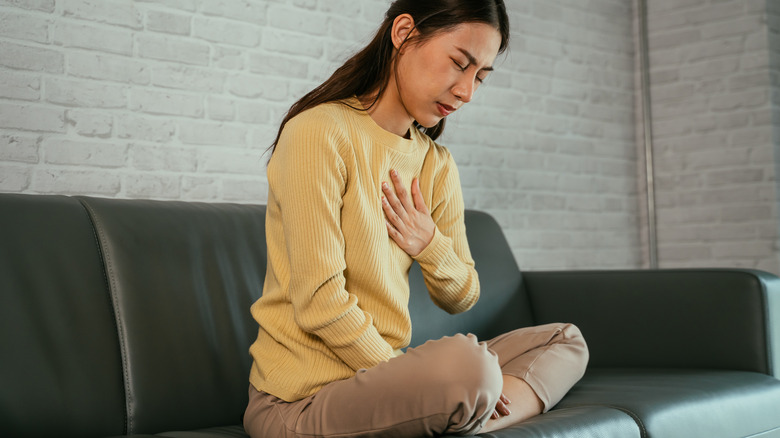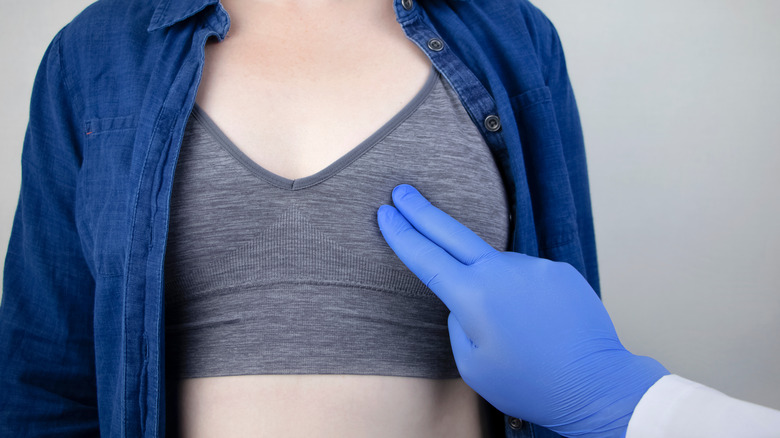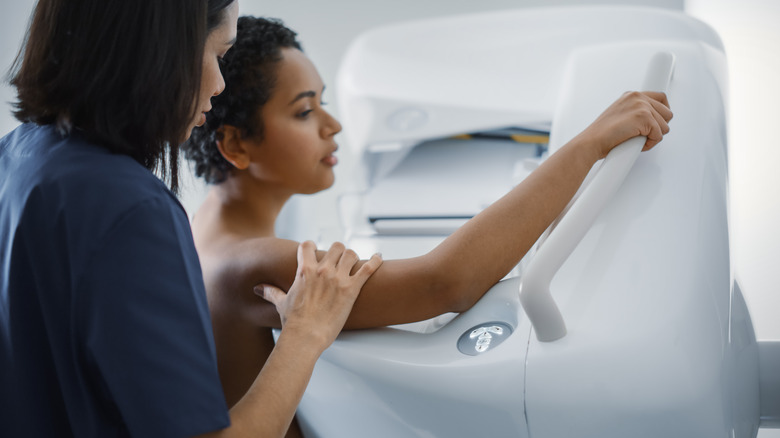What It Really Means When You Get Breast Lumps Before Your Period
Feeling a lump in your breast can be scary, no matter your age. However, you may have nothing to worry about, especially if the lump is painful or occurs before your period. More than 80% of breast lumps are benign, or non-cancerous, reports the Stony Brook University Cancer Center. Additionally, breast cancer rarely causes pain. Only 2% to 7% of those who find a painful lump in their breasts have malignant tumors, notes the Dana–Farber Cancer Institute.
Most women experience breast pain and tenderness around their period, which is perfectly normal. These symptoms are associated with mastalgia, a hormonal condition, explains Johns Hopkins University. Its causes are not fully understood, but researchers believe it may have something to do with the hormones progesterone and prolactin. Stress may play a role, too.
You might also experience localized breast pain at random times, which may be due to an injury, shingles, or costochondritis, according to 2015 research published in Diagnostic and Interventional Imaging. The latter is an inflammatory condition affecting the cartilage in the upper rib cage. Other potential causes include bone or muscle disorders, gastroesophageal reflux, or some medications, such as diuretics and antidepressants.
Breast lumps, however, are not that common — especially in teenagers and young women. On the positive side, this symptom is rarely a sign of cancer. That said, here's what it really means when you get breast lumps before your period.
You might have fibrocystic breasts
Breast lumps are often the result of fibrocystic changes, explains Beaumont Health. Also known as fibrocystic breast disease, this condition affects about 50% of women of reproductive age. The lumps are not always painful, but you may experience tenderness in the upper part of the breast. Some women may also have some pain and discomfort in the underarm area. These symptoms are most likely to occur before your period and affect both breasts.
Fibrocystic breast disease isn't a medical emergency and may not require treatment. Generally, it's triggered by the hormonal changes associated with menstruation, according to the Icahn School of Medicine at Mount Sinai. Self-help measures, such as applying cold compresses on your breasts and taking ibuprofen, may ease the pain. In more severe cases, doctors may prescribe birth control pills or hormone therapy.
This condition doesn't lead to breast cancer, but you should see a doctor if you find new lumps. Nipple discharge, skin redness, and breast lumps that persist after your period are not symptoms of fibrocystic breast disease. Reach out to your healthcare provider if you experience any of these issues. Also, note that it's uncommon to experience fibrocystic changes after menopause.
You may be dealing with a breast cyst
A soft, squishy lump on the breast could be a cyst. This problem is more common in women of reproductive age, but it may also occur after menopause, says the Mayo Clinic. Sometimes, breast cysts are accompanied by pain, tenderness, or discharge from the nipple. The lump may increase in size before your period starts and shrink afterward. Some women have multiple cysts, and some can reach 2 inches in diameter. In rare cases, the cysts may feel hard.
If you have a large cyst in your breast, your doctor may be able to drain it with a needle. This procedure is relatively painless and should relieve your symptoms, but the results may not last long. Breast cysts can refill with fluid in as little as 24 hours, according to the Royal Women's Hospital. On the positive side, they are harmless and won't increase your risk of getting breast cancer.
Breast cysts are often due to the changing levels of hormones during your menstrual cycle. Therefore, birth control pills and other hormonal drugs may help to some extent, notes the Mayo Clinic. You may also try ice or heat therapy and over-the-counter pain relievers, like naproxen sodium or acetaminophen. Alternatively, cut back on coffee and caffeinated foods or beverages, such as energy drinks, chocolate, and black tea.
Fibroadenomas are common causes of breast lumps
The hormonal changes occurring during your period may also cause fibroadenomas, explains the Westmead Breast Cancer Institute. This condition affects about 9% of women — especially those aged 21 to 25 — causing an overgrowth of breast tissue. Sometimes, it occurs during pregnancy and after menopause. The lumps are soft to the touch and can exceed 5 centimeters in diameter.
A fibroadenoma is a benign tumor and may go away on its own. Unlike fibrocystic breast disease, it doesn't cause pain and tenderness. Another difference is that you can feel the lump moving under your skin, explains WebMD. Also, it's possible to have multiple fibroadenomas at once. Your doctor will likely order a mammogram or breast ultrasound to rule out other conditions.
Fibroadenomas don't require treatment, but they can be surgically removed if necessary. For example, some women have large fibroadenomas that cause pain or alter the shape of their breasts. In such cases, doctors may cut out or freeze and remove the lump, notes the Mayo Clinic. Even after surgery, you may still get new lumps over the next few months or years. If that happens, see a medical professional for further testing.




